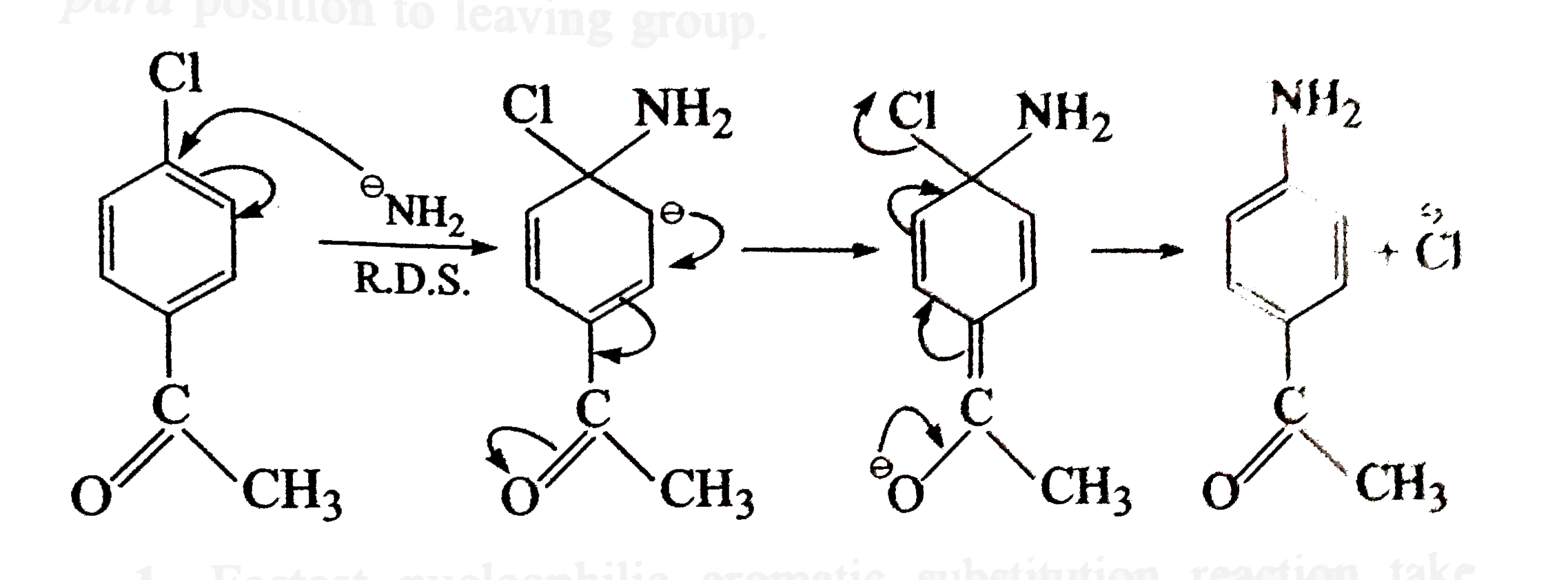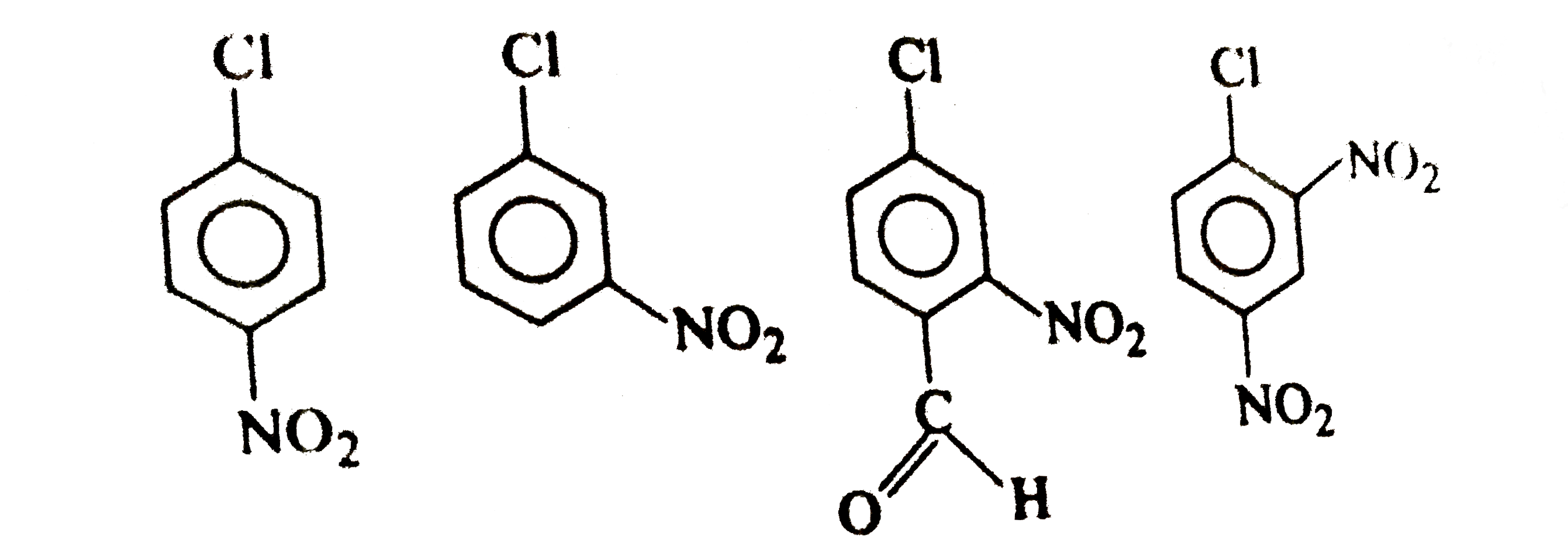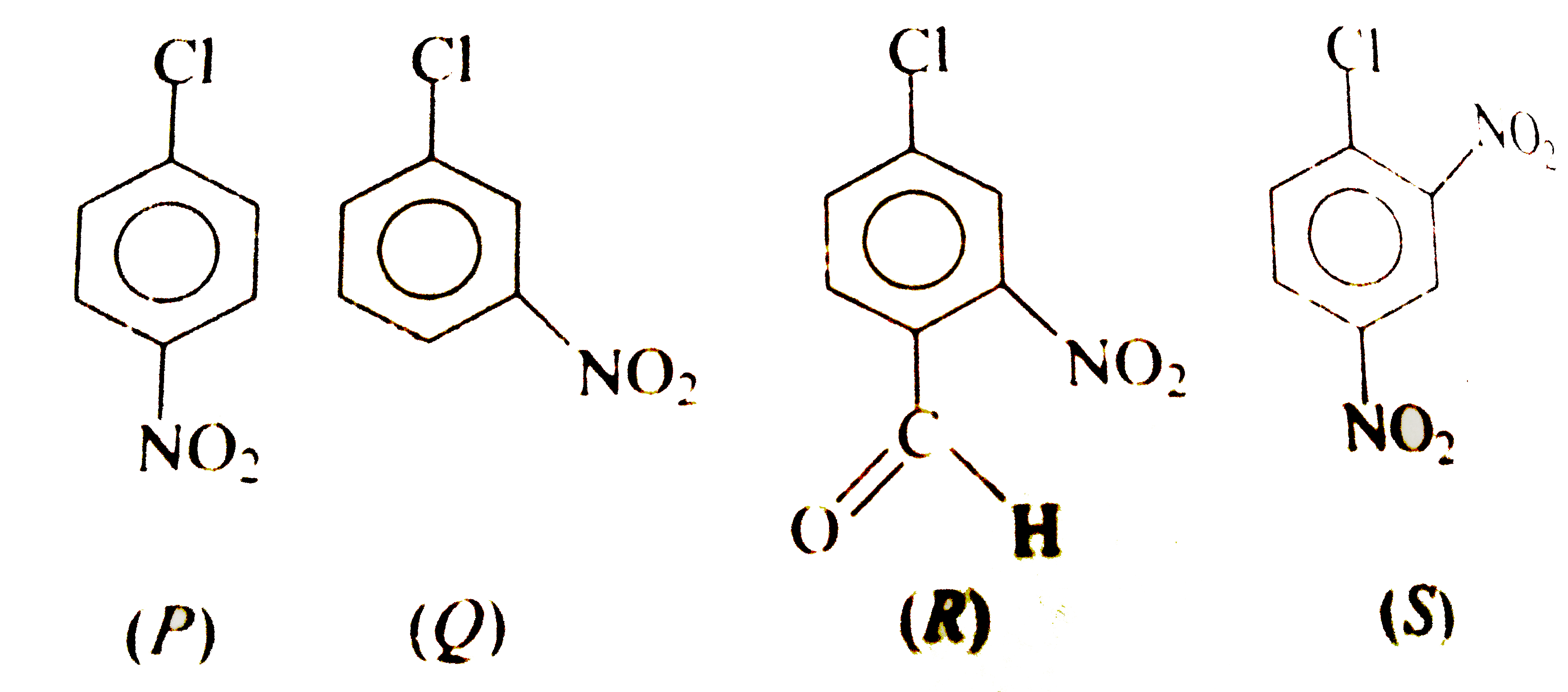Which represents nucleophilic aromatic substitution reaction ?
Reaction of benzene with Cl2 in sunlight
Benzyl bromide hydrolysis with water
Reaction of NaOH with dinitrofluoro benzene
Sulphonation of benzene
The correct Answer is:C
To determine which reaction represents a nucleophilic aromatic substitution, we need to analyze the options provided and identify the one that fits the criteria for this type of reaction.
1. Understanding Nucleophilic Aromatic Substitution:
- Nucleophilic aromatic substitution occurs when a nucleophile attacks an aromatic ring that has an electron-withdrawing group (EWG) attached. This reaction typically involves the substitution of a leaving group (like a halogen) on the aromatic ring.
2. Analyzing the Options:
- Option A: Reaction of benzene with Cl2 in sunlight.
- This is an electrophilic substitution reaction (halogenation) and does not involve nucleophilic substitution. (Incorrect)
- Option B: Benzyl bromide hydrolysis with water.
- Benzyl bromide (C6H5-CH2Br) undergoes hydrolysis, which involves the substitution of the bromine atom with an OH group, but it is not an aromatic substitution since the substitution occurs on the aliphatic carbon (CH2) and not on the aromatic ring. (Incorrect)
- Option C: Reaction of NaOH with dinitrofluorobenzene.
- Dinitrofluorobenzene has two nitro groups (which are strong electron-withdrawing groups) attached to the aromatic ring. The presence of these groups enhances the nucleophilic substitution reaction. Here, the hydroxide ion (OH-) acts as the nucleophile and attacks the carbon atom bonded to the fluorine, leading to the substitution of fluorine with OH. This is a classic example of nucleophilic aromatic substitution. (Correct)
- Option D: Sulfonation of benzene.
- This is an electrophilic substitution reaction where sulfur trioxide (SO3) or sulfuric acid (H2SO4) introduces a sulfonyl group (-SO3H) into the aromatic ring. (Incorrect)
3. Conclusion:
- The reaction that represents nucleophilic aromatic substitution is Option C: Reaction of NaOH with dinitrofluorobenzene.
- Nucleophilic aromatic substitution occurs when a nucleophile attacks an aromatic ring that has an electron-withdrawing group (EWG) attached. This reaction typically involves the substitution of a leaving group (like a halogen) on the aromatic ring.
- Option A: Reaction of benzene with Cl2 in sunlight.
- This is an electrophilic substitution reaction (halogenation) and does not involve nucleophilic substitution. (Incorrect)
- Option B: Benzyl bromide hydrolysis with water.
- Benzyl bromide (C6H5-CH2Br) undergoes hydrolysis, which involves the substitution of the bromine atom with an OH group, but it is not an aromatic substitution since the substitution occurs on the aliphatic carbon (CH2) and not on the aromatic ring. (Incorrect)
- Option C: Reaction of NaOH with dinitrofluorobenzene.
- Dinitrofluorobenzene has two nitro groups (which are strong electron-withdrawing groups) attached to the aromatic ring. The presence of these groups enhances the nucleophilic substitution reaction. Here, the hydroxide ion (OH-) acts as the nucleophile and attacks the carbon atom bonded to the fluorine, leading to the substitution of fluorine with OH. This is a classic example of nucleophilic aromatic substitution. (Correct)
- Option D: Sulfonation of benzene.
- This is an electrophilic substitution reaction where sulfur trioxide (SO3) or sulfuric acid (H2SO4) introduces a sulfonyl group (-SO3H) into the aromatic ring. (Incorrect)
- The reaction that represents nucleophilic aromatic substitution is Option C: Reaction of NaOH with dinitrofluorobenzene.
Topper's Solved these Questions
- ORGANIC COMPOUNDS WITH FUNCTIONAL GROUP CONTAINING HALOGENS Book:DINESH PUBLICATIONChapter:ORGANIC COMPOUNDS WITH FUNCTIONAL GROUP CONTAINING HALOGENS Exercise:Selected Straight Objective Type MCQs
Explore 78 Videos
- ORGANIC COMPOUNDS WITH FUNCTIONAL GROUP CONTAINING HALOGENS Book:DINESH PUBLICATIONChapter:ORGANIC COMPOUNDS WITH FUNCTIONAL GROUP CONTAINING HALOGENS Exercise:Linked Comprehension Type MCQs
Explore 8 Videos
- ORGANIC COMPOUNDS WITH FUNCTIONAL GROUP CONTAINING HALOGENS Book:DINESH PUBLICATIONChapter:ORGANIC COMPOUNDS WITH FUNCTIONAL GROUP CONTAINING HALOGENS Exercise:UNIT TEST - 5
Explore 37 Videos
- NO IDEABook:DINESH PUBLICATIONChapter:NO IDEAExercise:Unit Test -
Explore 1 Video
- POLYMERSBook:DINESH PUBLICATIONChapter:POLYMERSExercise:Matrix
Explore 5 Videos
Similar Questions
Which of the following molecules would have a carbon-halogen bond least susceptible to nucleophilic aromatic substitution reaction?
View SolutionFor a typical nucleophilic aromatic substitution reaction to take place .
1. Nucleophilic atom should be of oxygen nitrogen or sulphur.
2. Leaving groups should be halide.
3. There should be strong electron withdrawing at ortho and para position to leaving group.

Fastest nucleophilic aromatic substitution reaction take place in :
View Solution
Knowledge Check
For an electrophilic aromatic substitution reaction
AChlorine is o-p directing group and also electron releasing groupBChlorine is o-p directing group and also electron withdrawing groupCChlorine is meta directing group and also electron releasing groupDChlorine is meta directing group and also electron withdrawing groupWhich pairs are not required for a nucleophilic aromatic substitution reaction ?
AAn −NO2 substituent and a strong electrophile.BA ring bearing a strong activating group and a strong acid.CA aryl halide with an- NO2 and a strong nucelophileDAn unsubstituted benzene ring and a strong eletrophile.Which of the following compound is most reactive in the nucleophilic aromatic substitution reaction with NaOH ?
Ap− nitrofluorobenezeneBp−nitrochlorobenzeneCp−nitrobromobenzeneDp−nitroiodobenzene
For a typical nucleophilic aromatic subsitution reaction to take place.
(1) Nucleophilic atom should be of oxygen, nitrogen or sulphur.
(2) Leaving group should be halide .
(3) There should be strong electron withdarwing at ortho and para position to leaving group.

Fastest nucleophilic aromatic substitution reaction take place in :
View SolutionIdentify the compounds that will undergo nucleophilic aromatic substitution reaction :
View SolutionFind out correct statement regarding nucleophilic aromatic substitution reaction :
View SolutionFor a typical nucleophilic aromatic substitution reaction to take place .
1. Nucleophilic atom should be of oxygen nitrogen or sulphur.
2. Leaving groups should be halide.
3. There should be strong electron withdrawing at ortho and para position to leaving group.

Compare rate of nucleophilic aromatic substitution reaction in following reactants:

View SolutionFor a typical nucleophilic aromatic subsitution reaction to take place.
(1) Nucleophilic atom should be of oxygen, nitrogen or sulphur.
(2) Leaving group should be halide .
(3) There should be strong electron withdarwing at ortho and para position to leaving group.

Compare rate of nucleophilic aromatic substitution reaction in following reactants:
View Solution